change time CADILLAC ESCALADE EXT 2006 2.G Owner's Guide
[x] Cancel search | Manufacturer: CADILLAC, Model Year: 2006, Model line: ESCALADE EXT, Model: CADILLAC ESCALADE EXT 2006 2.GPages: 484, PDF Size: 2.98 MB
Page 388 of 484
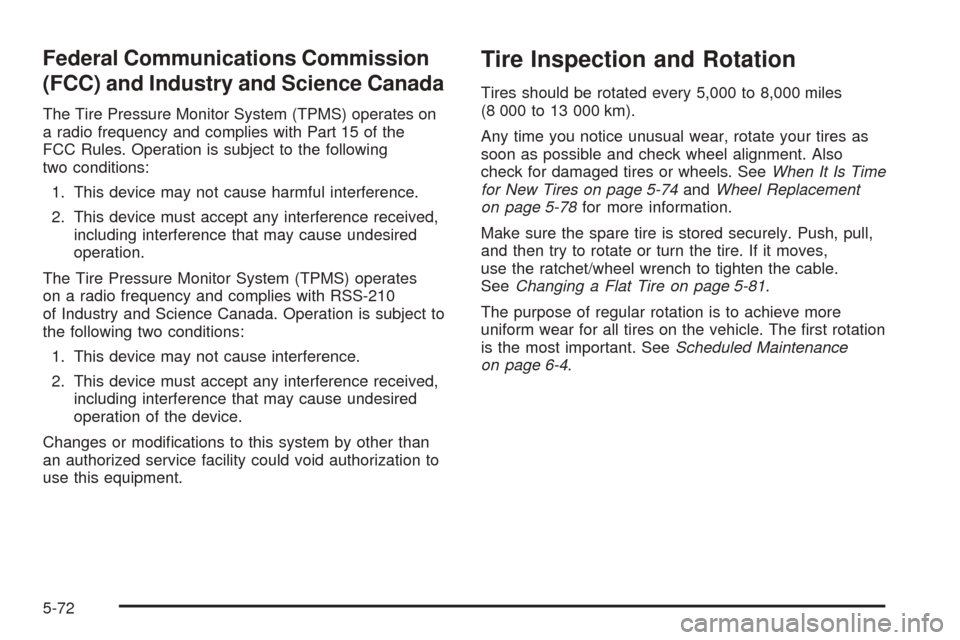
Federal Communications Commission
(FCC) and Industry and Science Canada
The Tire Pressure Monitor System (TPMS) operates on
a radio frequency and complies with Part 15 of the
FCC Rules. Operation is subject to the following
two conditions:
1. This device may not cause harmful interference.
2. This device must accept any interference received,
including interference that may cause undesired
operation.
The Tire Pressure Monitor System (TPMS) operates
on a radio frequency and complies with RSS-210
of Industry and Science Canada. Operation is subject to
the following two conditions:
1. This device may not cause interference.
2. This device must accept any interference received,
including interference that may cause undesired
operation of the device.
Changes or modi�cations to this system by other than
an authorized service facility could void authorization to
use this equipment.
Tire Inspection and Rotation
Tires should be rotated every 5,000 to 8,000 miles
(8 000 to 13 000 km).
Any time you notice unusual wear, rotate your tires as
soon as possible and check wheel alignment. Also
check for damaged tires or wheels. SeeWhen It Is Time
for New Tires on page 5-74andWheel Replacement
on page 5-78for more information.
Make sure the spare tire is stored securely. Push, pull,
and then try to rotate or turn the tire. If it moves,
use the ratchet/wheel wrench to tighten the cable.
SeeChanging a Flat Tire on page 5-81.
The purpose of regular rotation is to achieve more
uniform wear for all tires on the vehicle. The �rst rotation
is the most important. SeeScheduled Maintenance
on page 6-4.
5-72
Page 389 of 484
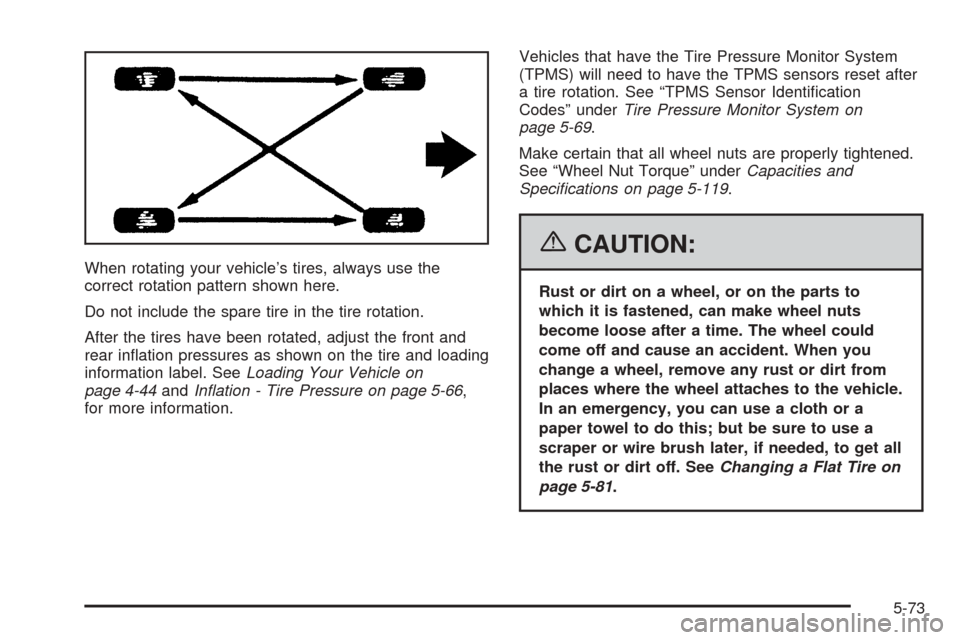
When rotating your vehicle’s tires, always use the
correct rotation pattern shown here.
Do not include the spare tire in the tire rotation.
After the tires have been rotated, adjust the front and
rear in�ation pressures as shown on the tire and loading
information label. SeeLoading Your Vehicle on
page 4-44andIn�ation - Tire Pressure on page 5-66,
for more information.Vehicles that have the Tire Pressure Monitor System
(TPMS) will need to have the TPMS sensors reset after
a tire rotation. See “TPMS Sensor Identi�cation
Codes” underTire Pressure Monitor System on
page 5-69.
Make certain that all wheel nuts are properly tightened.
See “Wheel Nut Torque” underCapacities and
Speci�cations on page 5-119.
{CAUTION:
Rust or dirt on a wheel, or on the parts to
which it is fastened, can make wheel nuts
become loose after a time. The wheel could
come off and cause an accident. When you
change a wheel, remove any rust or dirt from
places where the wheel attaches to the vehicle.
In an emergency, you can use a cloth or a
paper towel to do this; but be sure to use a
scraper or wire brush later, if needed, to get all
the rust or dirt off. SeeChanging a Flat Tire on
page 5-81.
5-73
Page 406 of 484
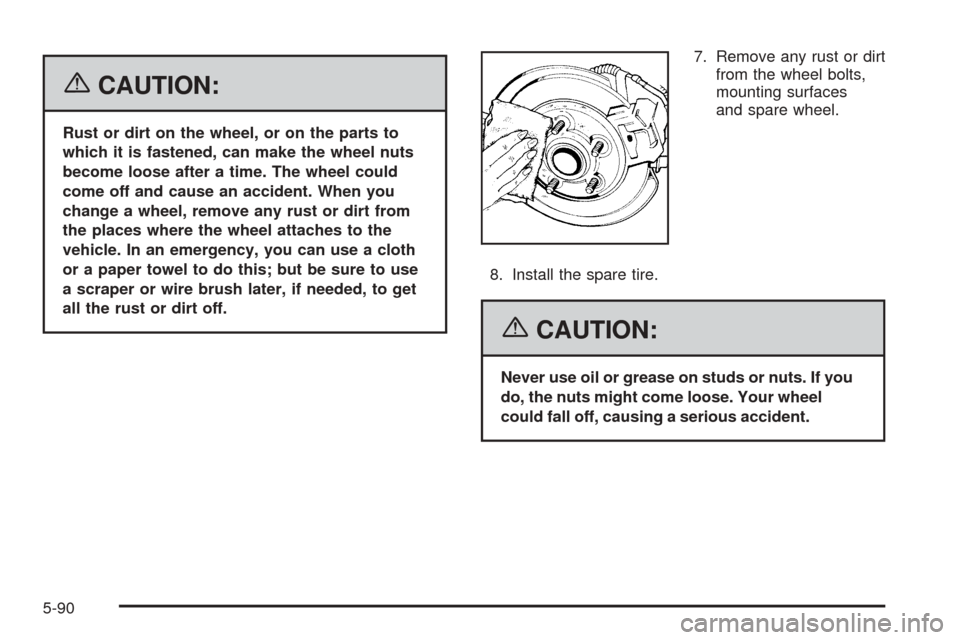
{CAUTION:
Rust or dirt on the wheel, or on the parts to
which it is fastened, can make the wheel nuts
become loose after a time. The wheel could
come off and cause an accident. When you
change a wheel, remove any rust or dirt from
the places where the wheel attaches to the
vehicle. In an emergency, you can use a cloth
or a paper towel to do this; but be sure to use
a scraper or wire brush later, if needed, to get
all the rust or dirt off.7. Remove any rust or dirt
from the wheel bolts,
mounting surfaces
and spare wheel.
8. Install the spare tire.
{CAUTION:
Never use oil or grease on studs or nuts. If you
do, the nuts might come loose. Your wheel
could fall off, causing a serious accident.
5-90
Page 438 of 484

Maintenance Schedule
Introduction
Important: Keep engine oil at the proper level and
change as recommended.
Have you purchased the GM Protection Plan? The Plan
supplements your new vehicle warranties. See your
Warranty and Owner Assistance booklet or your dealer
for details.
Maintenance Requirements
Notice:Maintenance intervals, checks, inspections,
replacement parts, and recommended �uids and
lubricants as prescribed in this manual are necessary
to keep your vehicle in good working condition.
Any damage caused by failure to follow scheduled
maintenance may not be covered by warranty.
Your Vehicle and the Environment
Proper vehicle maintenance not only helps to keep your
vehicle in good working condition, but also helps the
environment. All recommended maintenance is
important. Improper vehicle maintenance can even
affect the quality of the air we breathe. Improper �uid
levels or the wrong tire in�ation can increase the level of
emissions from your vehicle. To help protect our
environment, and to keep your vehicle in good condition,
be sure to maintain your vehicle properly.
Using the Maintenance Schedule
We at General Motors want to help you keep your
vehicle in good working condition. But we do not know
exactly how you will drive it. You may drive very
short distances only a few times a week. Or you may
drive long distances all the time in very hot, dusty
weather. You may use your vehicle in making deliveries.
Or you may drive it to work, to do errands, or in many
other ways.
6-2
Page 440 of 484

The proper replacement parts, �uids, and lubricants to
use are listed inRecommended Fluids and Lubricants
on page 6-12andNormal Maintenance Replacement
Parts on page 6-14. When your vehicle is serviced,
make sure these are used. All parts should be replaced
and all necessary repairs done before you or anyone
else drives the vehicle. We recommend the use of
genuine GM parts.
Scheduled Maintenance
When the CHANGE ENGINE OIL message comes on,
it means that service is required for your vehicle.
Have your vehicle serviced as soon as possible within the
next 600 miles (1 000 km). It is possible that, if you are
driving under the best conditions, the engine oil life
system may not indicate that vehicle service is necessary
for over a year. However, your engine oil and �lter must
be changed at least once a year and at this time the
system must be reset. Your GM Goodwrench
®dealer has
GM-trained service technicians who will perform this work
using genuine GM parts and reset the system.If the engine oil life system is ever reset accidentally,
you must service your vehicle within 3,000 miles
(5 000 km) since your last service. Remember to reset
the oil life system whenever the oil is changed. See
Engine Oil Life System on page 5-17for information on
the Engine Oil Life System and resetting the system.
When the CHANGE ENGINE OIL message appears,
certain services, checks, and inspections are required.
Required services are described in the following for
“MaintenanceI” and “MaintenanceII.” Generally,
it is recommended that your �rst service be
MaintenanceI, your second service be MaintenanceII,
and that you alternate MaintenanceIand MaintenanceII
thereafter. However, in some cases, MaintenanceII
may be required more often.
MaintenanceI— Use MaintenanceIif the CHANGE
ENGINE OIL message comes on within 10 months since
the vehicle was purchased or MaintenanceIIwas
performed.
MaintenanceII— Use MaintenanceIIif the previous
service performed was MaintenanceI. Always use
MaintenanceIIwhenever the message comes on
10 months or more since the last service or if the
message has not come on at all for one year.
6-4
Page 463 of 484
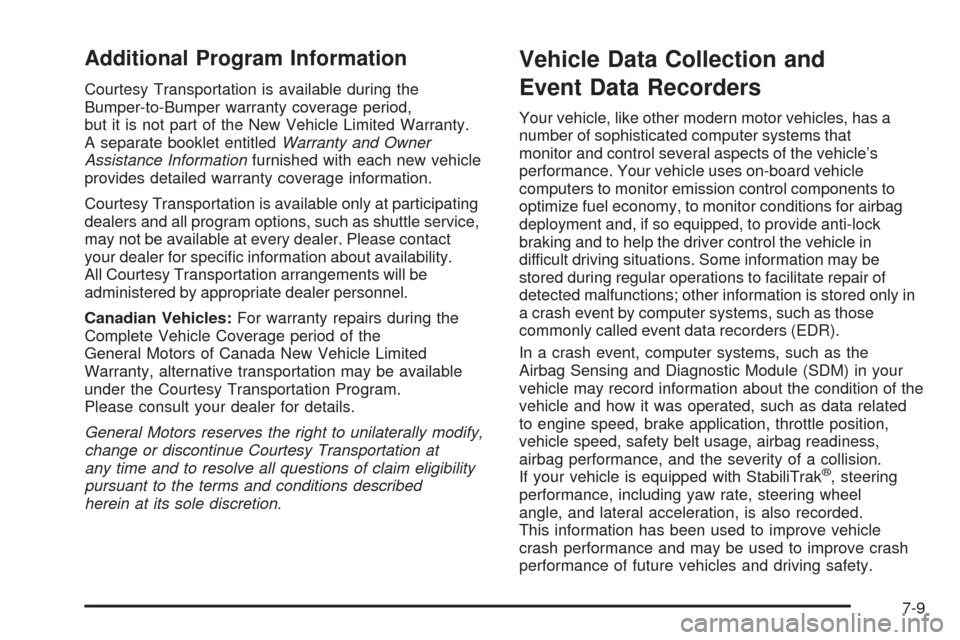
Additional Program Information
Courtesy Transportation is available during the
Bumper-to-Bumper warranty coverage period,
but it is not part of the New Vehicle Limited Warranty.
A separate booklet entitledWarranty and Owner
Assistance Informationfurnished with each new vehicle
provides detailed warranty coverage information.
Courtesy Transportation is available only at participating
dealers and all program options, such as shuttle service,
may not be available at every dealer. Please contact
your dealer for speci�c information about availability.
All Courtesy Transportation arrangements will be
administered by appropriate dealer personnel.
Canadian Vehicles:For warranty repairs during the
Complete Vehicle Coverage period of the
General Motors of Canada New Vehicle Limited
Warranty, alternative transportation may be available
under the Courtesy Transportation Program.
Please consult your dealer for details.
General Motors reserves the right to unilaterally modify,
change or discontinue Courtesy Transportation at
any time and to resolve all questions of claim eligibility
pursuant to the terms and conditions described
herein at its sole discretion.
Vehicle Data Collection and
Event Data Recorders
Your vehicle, like other modern motor vehicles, has a
number of sophisticated computer systems that
monitor and control several aspects of the vehicle’s
performance. Your vehicle uses on-board vehicle
computers to monitor emission control components to
optimize fuel economy, to monitor conditions for airbag
deployment and, if so equipped, to provide anti-lock
braking and to help the driver control the vehicle in
difficult driving situations. Some information may be
stored during regular operations to facilitate repair of
detected malfunctions; other information is stored only in
a crash event by computer systems, such as those
commonly called event data recorders (EDR).
In a crash event, computer systems, such as the
Airbag Sensing and Diagnostic Module (SDM) in your
vehicle may record information about the condition of the
vehicle and how it was operated, such as data related
to engine speed, brake application, throttle position,
vehicle speed, safety belt usage, airbag readiness,
airbag performance, and the severity of a collision.
If your vehicle is equipped with StabiliTrak
®, steering
performance, including yaw rate, steering wheel
angle, and lateral acceleration, is also recorded.
This information has been used to improve vehicle
crash performance and may be used to improve crash
performance of future vehicles and driving safety.
7-9
Page 469 of 484
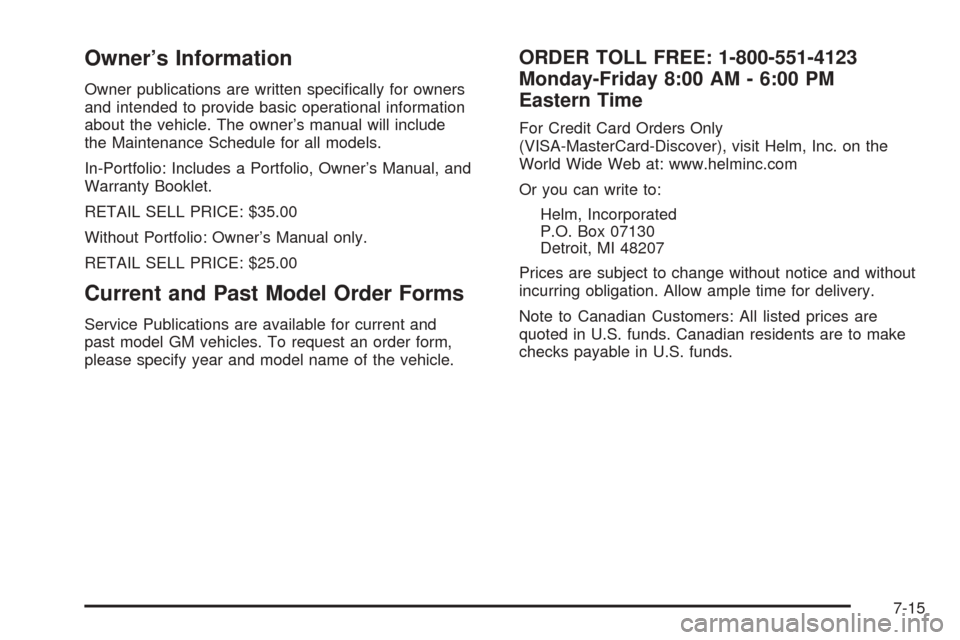
Owner’s Information
Owner publications are written speci�cally for owners
and intended to provide basic operational information
about the vehicle. The owner’s manual will include
the Maintenance Schedule for all models.
In-Portfolio: Includes a Portfolio, Owner’s Manual, and
Warranty Booklet.
RETAIL SELL PRICE: $35.00
Without Portfolio: Owner’s Manual only.
RETAIL SELL PRICE: $25.00
Current and Past Model Order Forms
Service Publications are available for current and
past model GM vehicles. To request an order form,
please specify year and model name of the vehicle.
ORDER TOLL FREE: 1-800-551-4123
Monday-Friday 8:00 AM - 6:00 PM
Eastern Time
For Credit Card Orders Only
(VISA-MasterCard-Discover), visit Helm, Inc. on the
World Wide Web at: www.helminc.com
Or you can write to:
Helm, Incorporated
P.O. Box 07130
Detroit, MI 48207
Prices are subject to change without notice and without
incurring obligation. Allow ample time for delivery.
Note to Canadian Customers: All listed prices are
quoted in U.S. funds. Canadian residents are to make
checks payable in U.S. funds.
7-15
Page 472 of 484
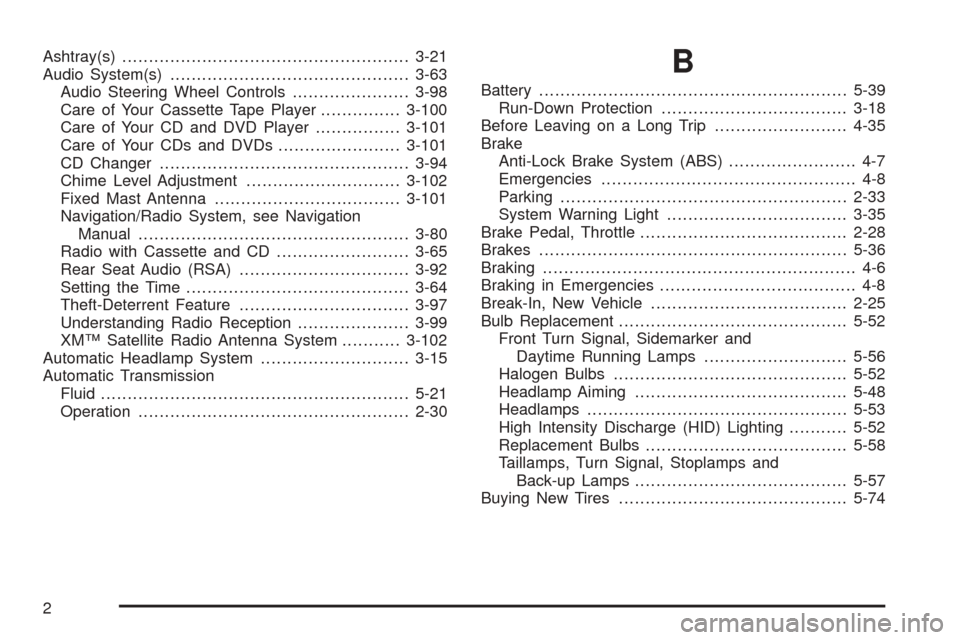
Ashtray(s)......................................................3-21
Audio System(s).............................................3-63
Audio Steering Wheel Controls......................3-98
Care of Your Cassette Tape Player...............3-100
Care of Your CD and DVD Player................3-101
Care of Your CDs and DVDs.......................3-101
CD Changer...............................................3-94
Chime Level Adjustment.............................3-102
Fixed Mast Antenna...................................3-101
Navigation/Radio System, see Navigation
Manual...................................................3-80
Radio with Cassette and CD.........................3-65
Rear Seat Audio (RSA)................................3-92
Setting the Time..........................................3-64
Theft-Deterrent Feature................................3-97
Understanding Radio Reception.....................3-99
XM™ Satellite Radio Antenna System...........3-102
Automatic Headlamp System............................3-15
Automatic Transmission
Fluid..........................................................5-21
Operation...................................................2-30B
Battery..........................................................5-39
Run-Down Protection...................................3-18
Before Leaving on a Long Trip.........................4-35
Brake
Anti-Lock Brake System (ABS)........................ 4-7
Emergencies................................................ 4-8
Parking......................................................2-33
System Warning Light..................................3-35
Brake Pedal, Throttle.......................................2-28
Brakes..........................................................5-36
Braking........................................................... 4-6
Braking in Emergencies..................................... 4-8
Break-In, New Vehicle.....................................2-25
Bulb Replacement...........................................5-52
Front Turn Signal, Sidemarker and
Daytime Running Lamps...........................5-56
Halogen Bulbs............................................5-52
Headlamp Aiming........................................5-48
Headlamps.................................................5-53
High Intensity Discharge (HID) Lighting...........5-52
Replacement Bulbs......................................5-58
Taillamps, Turn Signal, Stoplamps and
Back-up Lamps........................................5-57
Buying New Tires...........................................5-74
2
Page 480 of 484
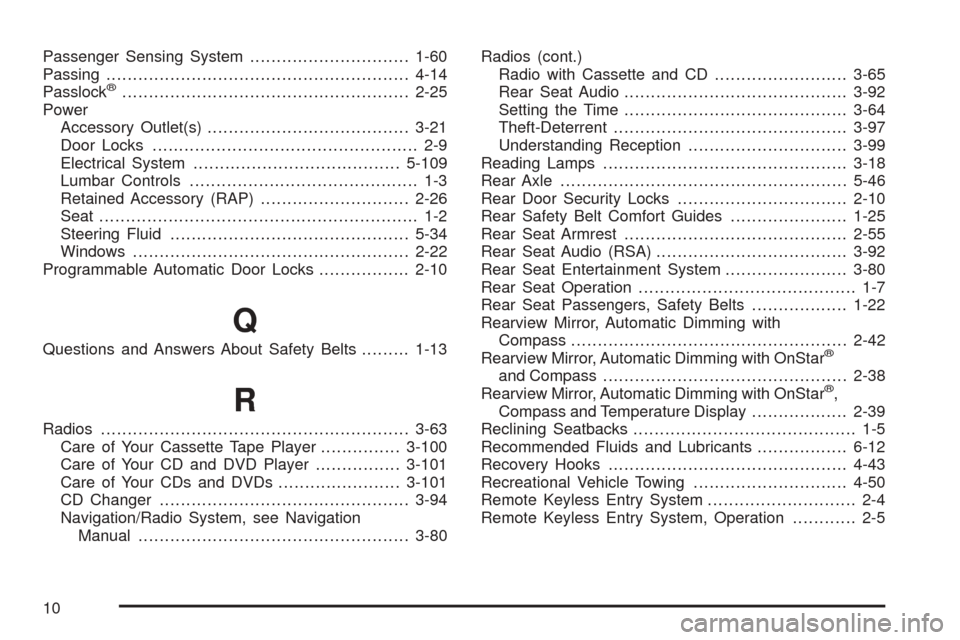
Passenger Sensing System..............................1-60
Passing.........................................................4-14
Passlock
®......................................................2-25
Power
Accessory Outlet(s)......................................3-21
Door Locks.................................................. 2-9
Electrical System.......................................5-109
Lumbar Controls........................................... 1-3
Retained Accessory (RAP)............................2-26
Seat............................................................ 1-2
Steering Fluid.............................................5-34
Windows....................................................2-22
Programmable Automatic Door Locks.................2-10
Q
Questions and Answers About Safety Belts.........1-13
R
Radios..........................................................3-63
Care of Your Cassette Tape Player...............3-100
Care of Your CD and DVD Player................3-101
Care of Your CDs and DVDs.......................3-101
CD Changer...............................................3-94
Navigation/Radio System, see Navigation
Manual...................................................3-80Radios (cont.)
Radio with Cassette and CD.........................3-65
Rear Seat Audio..........................................3-92
Setting the Time..........................................3-64
Theft-Deterrent............................................3-97
Understanding Reception..............................3-99
Reading Lamps..............................................3-18
Rear Axle......................................................5-46
Rear Door Security Locks................................2-10
Rear Safety Belt Comfort Guides......................1-25
Rear Seat Armrest..........................................2-55
Rear Seat Audio (RSA)....................................3-92
Rear Seat Entertainment System.......................3-80
Rear Seat Operation......................................... 1-7
Rear Seat Passengers, Safety Belts..................1-22
Rearview Mirror, Automatic Dimming with
Compass....................................................2-42
Rearview Mirror, Automatic Dimming with OnStar
®
and Compass..............................................2-38
Rearview Mirror, Automatic Dimming with OnStar®,
Compass and Temperature Display..................2-39
Reclining Seatbacks.......................................... 1-5
Recommended Fluids and Lubricants.................6-12
Recovery Hooks.............................................4-43
Recreational Vehicle Towing.............................4-50
Remote Keyless Entry System............................ 2-4
Remote Keyless Entry System, Operation............ 2-5
10
Page 482 of 484

Service (cont.)
Doing Your Own Work................................... 5-4
Engine Soon Light.......................................3-39
Publications Ordering Information...................7-14
Servicing Your Airbag-Equipped Vehicle..............1-64
Setting the Time.............................................3-64
Sheet Metal Damage.....................................5-106
Shifting Into Park (P).......................................2-34
Shifting Out of Park (P)...................................2-35
Signals, Turn and Lane-Change.......................... 3-7
Spare Tire.....................................................5-99
Installing....................................................5-86
Removing...................................................5-82
Storing.......................................................5-96
Speci�cations, Capacities...............................5-119
Speedometer..................................................3-30
StabiliTrak
®System.......................................... 4-9
Starting Your Engine.......................................2-27
Steering........................................................4-12
Steering Wheel Controls, Audio.........................3-98
Steering Wheel, Tilt Wheel................................. 3-6
Storage Areas
All-Weather Cargo Area................................2-68
Center Console Storage Area........................2-53
Cupholder(s)...............................................2-53
Glove Box..................................................2-53
Instrument Panel Storage Area......................2-53Storage Areas (cont.)
Luggage Carrier..........................................2-54
Rear Seat Armrest.......................................2-55
Top-Box Storage..........................................2-72
Stuck in Sand, Mud, Ice or Snow......................4-42
Sun Visors.....................................................2-23
Sunroof.........................................................2-73
T
Tachometer....................................................3-30
Tailgate.........................................................2-19
Taillamps
Turn Signal, Stoplamps and Back-up Lamps......5-57
Theft-Deterrent, Radio.....................................3-97
Theft-Deterrent Systems...................................2-23
Content Theft-Deterrent................................2-23
Passlock
®...................................................2-25
Throttle, Adjustable..........................................2-28
Tilt Wheel........................................................ 3-6
Tires.............................................................5-60
Aluminum or Chrome-Plated Wheels,
Cleaning...............................................5-105
Buying New Tires........................................5-74
Chains.......................................................5-79
Changing a Flat Tire....................................5-81
Cleaning...................................................5-106
12